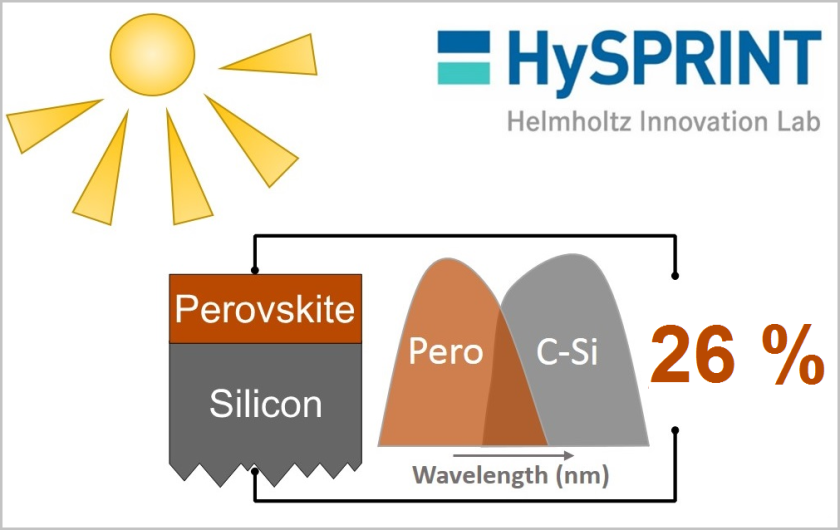Innovation Lab HySPRINT
High and higher… Tandem solar cell-efficiency further improved
05.06.2019
New paper on monolithic perovskite/silicon tandem solar cells with 26% efficiency made in the HySPRINT perovskite lab has been published in “Sustainable Energy & Fuels”.
Silicon/perovskite tandem photovoltaic devices based on the well-developed silicon technology and cost-effective perovskite production are very promising. The combination of these two materials allows an effective conversion of the absorbed sunlight into electrical power in a wide range from visible light to near infrared. Prof. Steve Albrecht’s group develops metal-halide perovskite materials constantly improving the solar cell efficiency.
Previously, Dr. Marko Jošt from the group announced a monolithic tandem solar cell with an advanced light trapping giving a power conversion efficiency (PCE) of 25.5% i. In the new work, PhD candidate Eike Köhnen presents a monolithic perovskite/silicon solar cell with an outstanding 26% PCE. This is the highest tandem solar cell efficiency published in a scientific journal so far.
Köhnen and his colleagues have used a silicon hetero junction bottom cell with textured rear side and polished front side (provided by the HZB institute PVcomB) on which the perovskite top cell is deposited. The group has advanced the photocurrent matching characteristics of the sub-cells in a monolithic tandem. By optimizing the bottom and top cell, the reflection and parasitic losses are reduced giving the overall parasitic absorption below 1%. The largest current that can be obtained from the solar cell (Jsc) is as high as 19.2 mA cm-2. The fill factor, FF, one of the parameters giving the quality of the photovoltaic device, is 76.5%, whereas the open circuit voltage VOC is 1.77 V. Simulations performed by the group show that the electrical performance of these monolithic tandem cell can be further advanced. Eike Köhnen points out, “We predict up to 31% PCE what is higher than the expected limitation of 29.4% for the purely silicon solar cells”.
Last year Köhnen was awarded with a poster prize for this research work at the 4th International Conference on Perovskite Solar Cells and Optoelectronics (PSCO) conference in Lausanne, Switzerland ii.
“Our excellent infrastructure and highly motivated team enable cutting-edge R&D to bring the tandem solar cell technology closer to the market”, says Stefan Gall, manager of the Helmholtz Innovation Lab HySPRINT.
Read the full article in “Sustainable Energy & Fuels” (open access):
“Highly Efficient Monolithic Perovskite Silicon Tandem Solar Cells: Analyzing the Influence of Current Mismatch on Device Performance”; E. Köhnen et al.; DOI: 10.1039/C9SE00120D (2019)
Follow our perovskite silicon tandem solar cell on its tour through different cities on Twitter at #TandemOnTour.
Mariia A.

